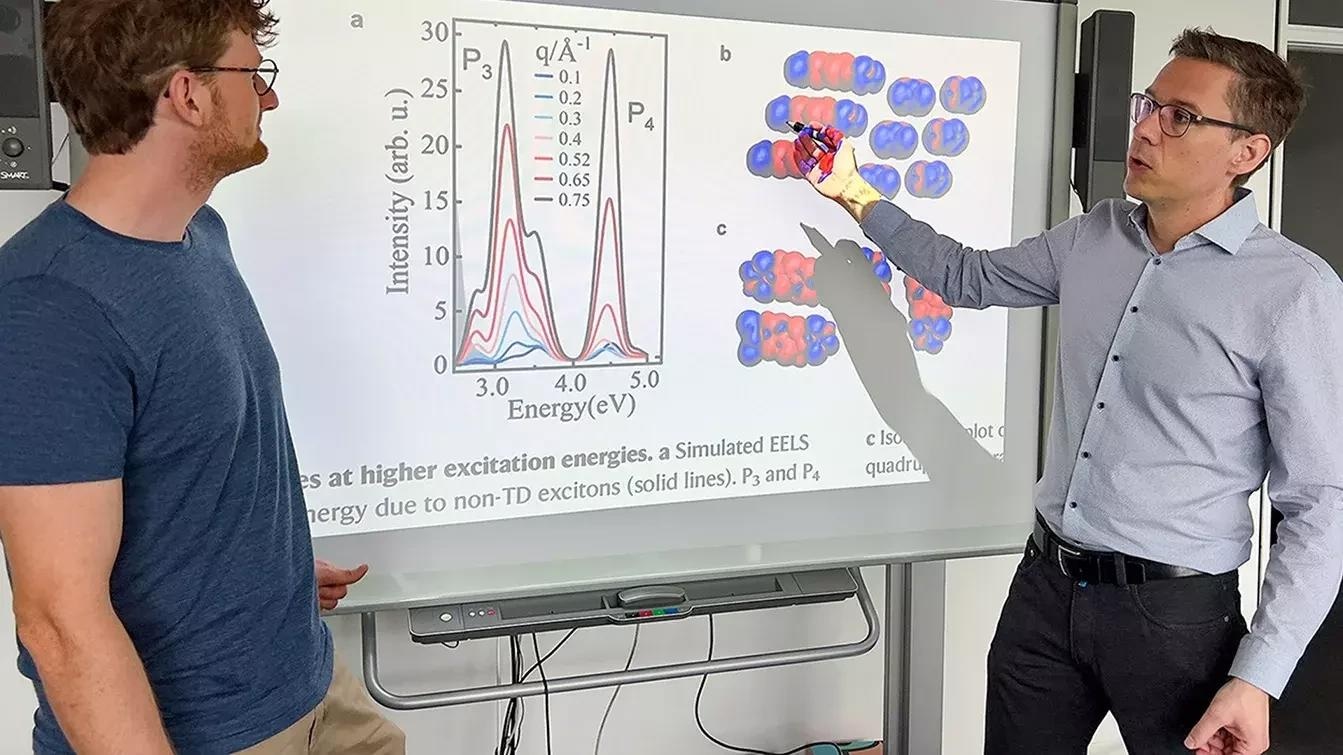The sun emits vast amounts of energy towards Earth; however, some of this energy is lost within solar cells. This presents a challenge when it comes to utilizing organic solar cells, particularly for innovative applications.
 Prof. Frank Ortmann (right) and Maximilian Dorfner discuss how specific molecules can increase the efficiency of organic solar cells. Image Credit: Technical University of Munich
Prof. Frank Ortmann (right) and Maximilian Dorfner discuss how specific molecules can increase the efficiency of organic solar cells. Image Credit: Technical University of Munich
A critical factor in enhancing their efficiency lies in improving the transport of the solar energy stored within the material. Recently, a research team at the Technical University of Munich (TUM) has demonstrated that specific organic dyes can play a pivotal role in creating virtual pathways for this energy, potentially overcoming this hurdle.
Organic solar cells, known for their lightweight and ultra-thin nature, serve as efficient energy collectors and can be applied as flexible coatings on a wide range of surfaces. These solar cells, built upon organic semiconductors, offer many potential applications, such as solar panels and films that can be conveniently rolled up, or integrated into smart devices.
However, a common drawback in many of these applications is the relatively inefficient transport of the collected energy within the material. Consequently, researchers are delving into the fundamental transport mechanisms of organic solar cells to identify methods for enhancing this energy transport.
Stimulating Sunlight
Among these researchers, Frank Ortmann, who holds the position of Professor of Theoretical Methods in Spectroscopy at TUM, and his colleagues based in Dresden, place their primary emphasis on understanding the intricate interplay between light and material. Their specific focus lies on investigating the behavior of entities known as excitons.
Excitons are something like the fuel of the sun, which has to be used optimally. When light energy in the form of a photon collides with the material of a solar cell it is absorbed and buffered as an excited state. This intermediate state is referred to as an exciton.
Frank Ortmann, Professor, Theoretical Methods in Spectroscopy, Technical University of Munich
Ortmann is also a member of the “e-conversion” Excellence Cluster.
These charges, known as excitons, cannot be harnessed for electrical energy until they reach a specifically designed interface. Ortmann and his research team have recently demonstrated the possibility of constructing exciton transport highways using organic dyes.
Turbocharger Dyes
The critical importance of ensuring that excitons reach this interface as swiftly as possible is attributed to their relatively brief lifespan.
The faster and more targeted the transport, the higher the energy yield, and thus the higher the efficiency of the solar cell.
Frank Ortmann, Professor, Theoretical Methods in Spectroscopy, Technical University of Munich
The molecules of these organic dyes, known as quinoid merocyanines, facilitate this process due to their unique chemical structure and their exceptional capacity to absorb visible light. Consequently, they are well-suited for deployment as the active layer within an organic solar cell, as elaborated by Ortmann.
Energy Packets in the Fast Lane
Employing spectroscopic measurements and computational models, the researchers were able to observe the excitons swiftly traversing through the dye molecules.
The value of 1.33 electron volts delivered by our design is far above the values found in organic semiconductors – you could say the organic dye molecules form a kind of super-highway.
Frank Ortmann, Professor, Theoretical Methods in Spectroscopy, Technical University of Munich
These groundbreaking discoveries hold the potential to lay the groundwork for precise and more efficient exciton transport within organic materials, thus expediting the advancement of organic solar cells and organic light-emitting diodes with significantly enhanced performance levels.
Journal Reference:
Müller, K., et al. (2023). Directed exciton transport highways in organic semiconductors. Nature Communications. doi.org/10.1038/s41467-023-41044-9.